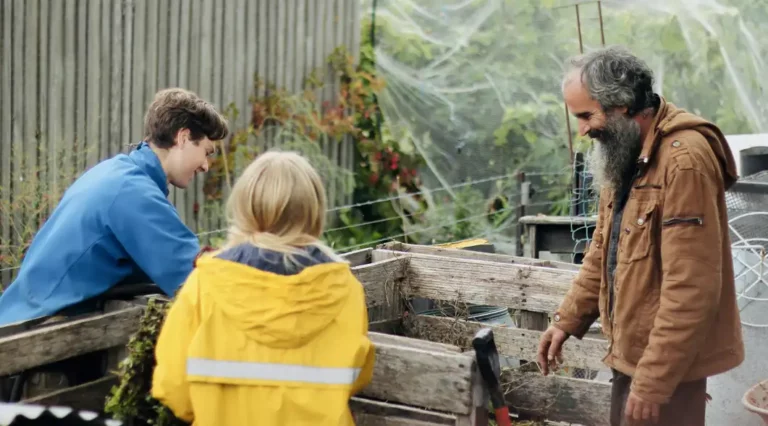The 30 km to Kalgoorlie to Coolgardie was marked by mine haul road intersections and of course C. Y. O’Connor’s great pipeline. David’s memory of Coolgardie was as a “ghost mining town” where he stayed at the youth hostel in 1972 when hitchhiking around Australia from his hometown of Fremantle. Today kerb and channel streets with planted Western Woodland eucalypts and modern, if modest, houses have masked most of the sense of ghost town.
Our drive around town did reveal lots of empty shops, and the odd house with hand painted for sale signs for $80,000, and ¼ building blocks for $20,000. Maybe the sense of a real town rather than the ghost town in David memory, from nearly half a century ago, could be attributed to three factors. The revival of mining and grey nomad tourism were the obvious ones but perhaps the growth of the indigenous population still attached to country was another. With this growth in number has come a plethora of services and other government expenditure focused on reversing the appalling health and wellbeing indices for Indigenous Australians. The economic activity associated with what some disparaging refer to as the “aboriginal industry” is certainly a major factor keeping towns like Coolgardie alive and is perhaps one of the factors ameliorating the long established racism that has characterised white attitudes in outback Australia. Whatever the case, it seems aboriginal people and culture are, over time, reclaiming at least the harsher parts of this continent in which white people seem mostly to be temporary residents attached to extractive industries that have no future.
These thoughts were penned in a degraded but beautiful camp just out of town amongst the metallic barked gums where the remnants of past diggings were dwarfed by new open cut mines not far away.
Next morning we checked out the town first from the Lions Lookout with its relocated mining relics and spectacular moonscape of the most diverse forms and colours of earth and rock Su had ever seen; to match the amazing forms and colours of the vegetation of the eastern goldfields (all part of the Great Western Woodlands). Next we visited the building that David remembered as the youth hostel that is now the restored residence of Warden (and Magistrate) Finnerty of Coolgardie Court in the 1890s. The kind caretaker of the now National Trust museum opened early for us to look around. While noting the ingenious passive wall to lantern roof ventilation to provide relief from the searing summer heat, the evaporative food safe named after the town and the period furniture, it gradually dawned on David that the woman of the house must have been a contemporary of his maternal grandmother Pearl Myslis and that Finnerty must have been her father, Joseph Myslis’, boss in his position as “Bailiff for the Mining Warden’s Court”.
The massive goal, post office and registrar’s office in the main street seemed as regal as in memory. Before becoming the bailiff Joseph Myslis had run a grocery business in a tent assisted by his teenage daughter. In 1903 the family moved to Government House in Perth where Joseph was clerical assistant. It seemed to David that in living at Government House Pearl became used to the finer aspect of gold boom Perth around the coattails of the emerging colonial nouveau riche.
The helpful women on the desk in the Court House museum checked the records for relatives. This lead us to visiting the cemetery where from 1894 to 1900 there were 1000 internments, most under 30, many children and babies, from the typhoid epidemics. We checked out the graves in the Jewish section that contain at least one Myslis relative and the Afghan section that, like the Jewish section included modern restorations.
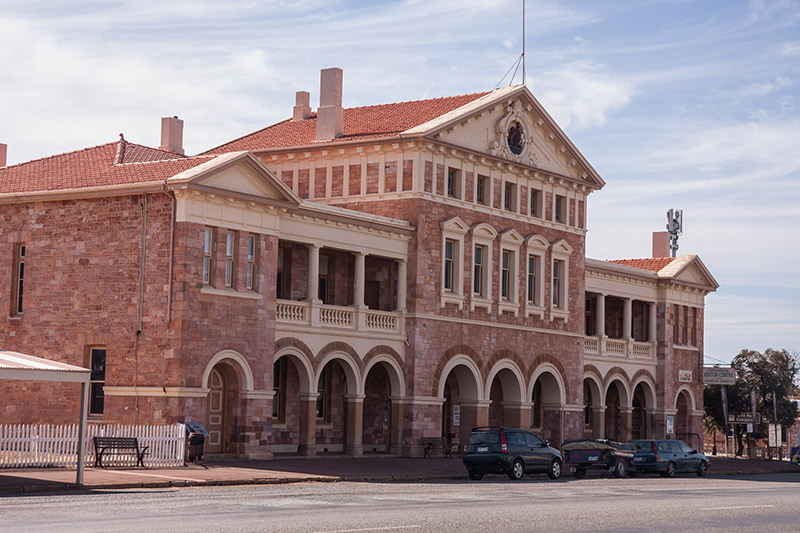
The imposing court house, now museum in the centre of Coolgardie built 1898 only 6 years after the discovery of gold; a great symbol of power and order over the wild west gold town that peaked with a population of over 15,000 people
After a coffee at the pub, a natter with locals and the publican, we headed west to Southern Cross where the great clearings of the WA wheatbelt start to replace the woodlands. The empty shop index seemed as bad as Norseman. It seemed like broadacre cropping wasn’t sustaining towns against the onslaught of centralisation and the internet any better than mining. In the land of crops and fences, the choices for campsites were fewer and the name Moorine Rock sounded good. Google Maps showed it as just off the highway but while checking the phone on the side of a dirt road a friendly bloke in a mining vehicle asked if we were looking for Moorine Rock which he informed us was just 15km down the road next to his place. We followed the dispersing cloud of dust down roads between green crops, pastures, large salmon gums and wandoos, got lost at one point at which Su spat the dummy about this being a ridiculous search while David doggedly followed his intuition, eventually turning at a small sign saying Hunts Soak with the outline of a large long monolith against the dusk sky. We had found the place that was going to be our last great bush camp before getting back to civilisation (as David’s mother was prone to say after being in the bush).
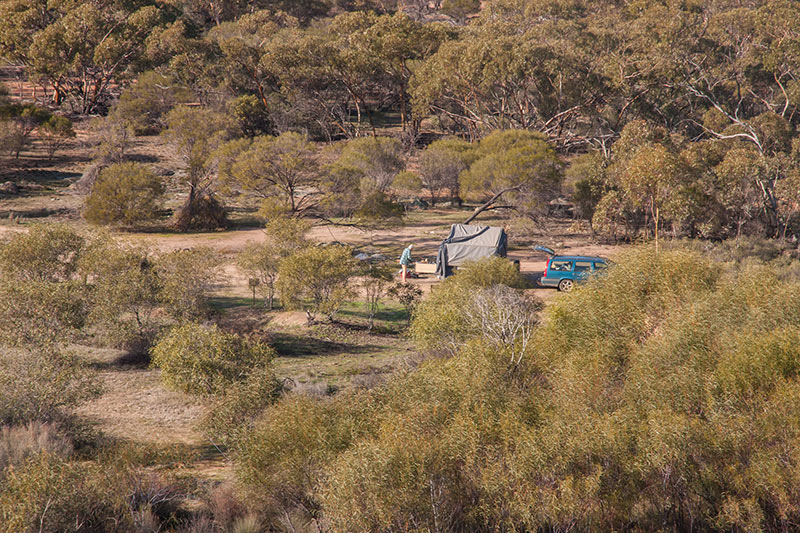
Our final bush camp at Moorine Rock before re-entry to civilization
Next morning Su stayed in bed and it became clear that two days in York was being replaced by two days at Moorine Rock. We both did housekeeping and repair catch up, explored the micro and macro landscapes, David went crazy with photography and Su’s mood lifted and floated away as she connected to the spirit of this place. Light rain overnight refilled the pools on the Rock allowing us to collect good potable water without having to consume the chlorinated stuff we got at Kalgoorlie, while conserving the last of our Melrose rainwater for drinking. Moorine Rock is marked primarily by the reconstruction of a stone well dug by Hunt, the explorer to whom the local Noongar people gave a visitors welcome in 1864 without understanding the onslaught that was coming with white people finding gold to the east.
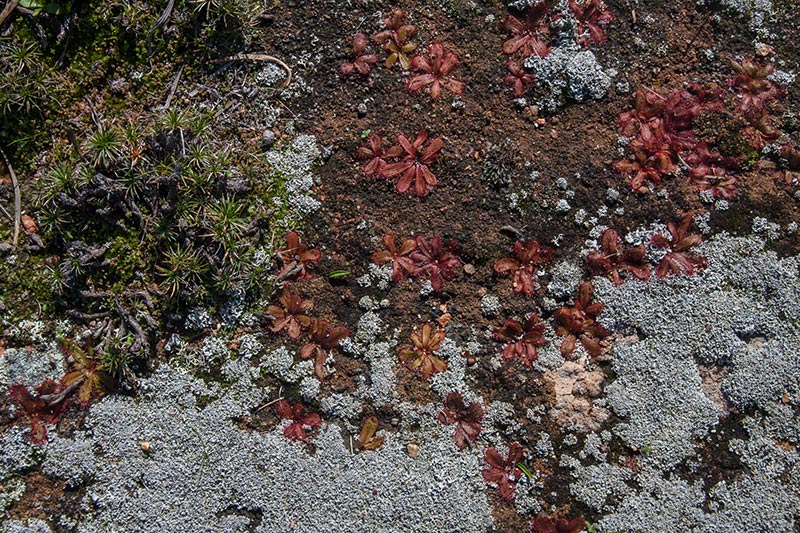
The micro-landscapes of Moorine Rock
Heading west into the high rainfall heart of the wheat belt, we checked out Merredin, relatively prosperous service centre, photographed yet another incredible planted Sugar Gum (from 1920 and 50 m tall in 1986). The seed was without doubt from the southern Flinders provenance we had been visiting the week before. As is so often the case, Sugar Gum exhibits what foresters call “exotic vigour” growing better away from home territory.
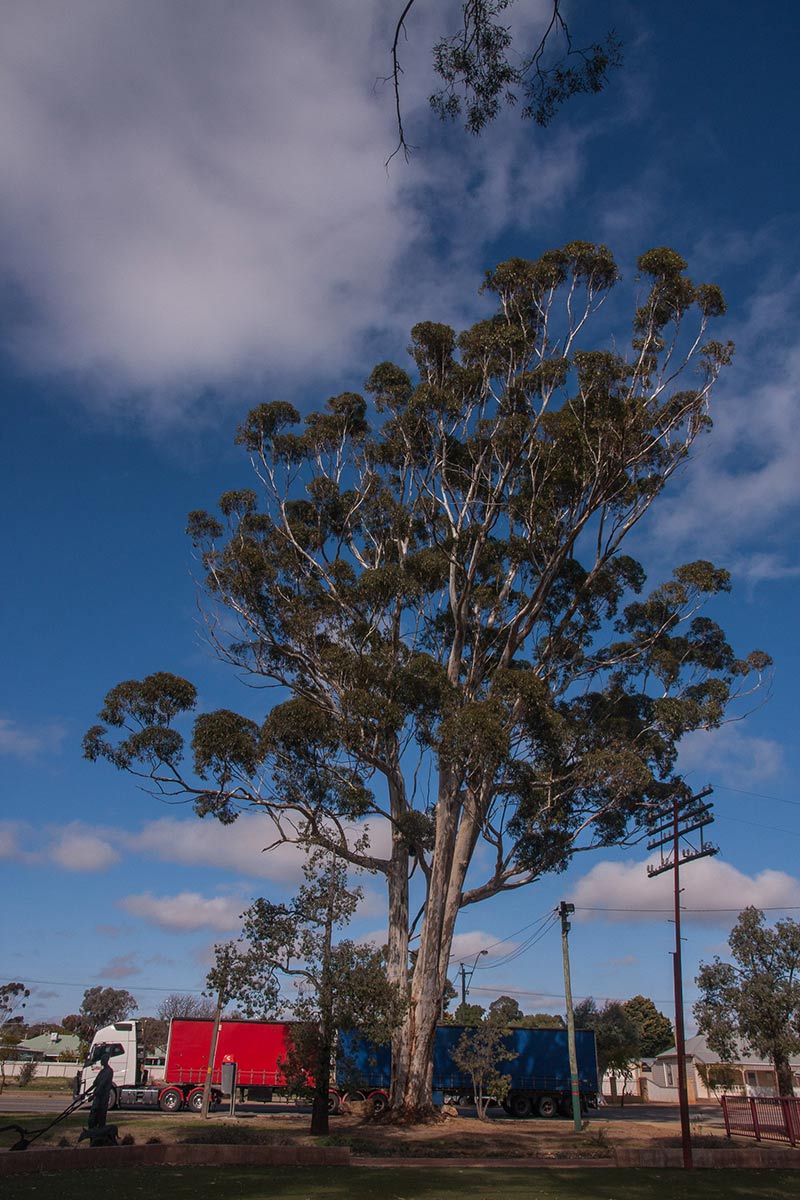
Sugar Gum dwarfing passing road train on Great Eastern Highway Merredin
As we travelled towards York the contrast between the grain crops and pasture on the one hand and the ubiquitous salinity down almost every drainage line and depression became more extreme. Out in the semi-arid zone of the ancient WA shield tablelands (one of the oldest landmasses in the world), salinity felt a harmonious part of the landscapes but in these better watered farmlands it felt like running sores ameliorated here and there by heroic revegetation efforts of landholders over the last 40 years or so. Saltbush plantings on the salt flats seemed like steps towards a more sustainable – even permaculture – vision for this country. But these small contributions to creating perennial wood pasture (silvopasture) seem to have had minimal effect on farm economics of the wheat belt where cropping is king.
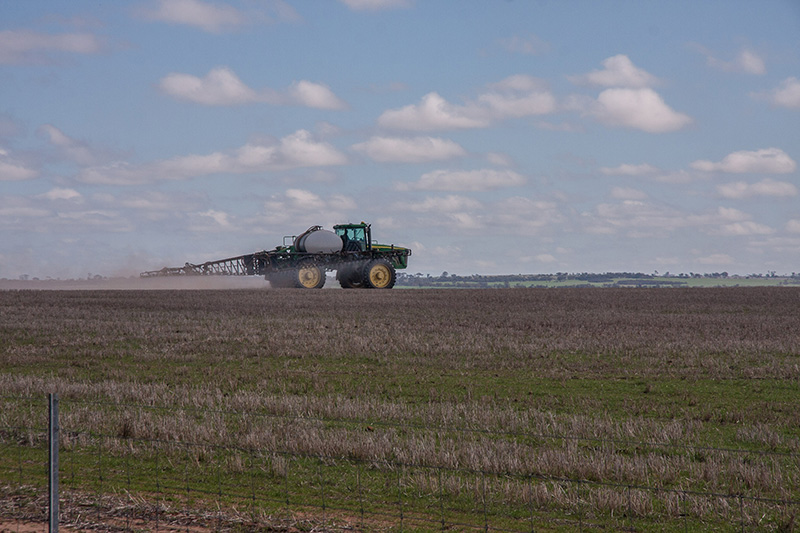
Spray rig working a broadacre cropping paddock at speeds not much slower than we do on the highway
The other change as we got closer to York, more of the plants including flowering hakea and the iconic xanthorrhoea reminded David of where he grew up on the Swan River, but York was where his mother spent her childhood and it was her stories that directed us now. First to Mount Brown (ah yes – once covered in pink and blue wildflowers in the spring David recalls Venie saying) to have a late lunch, make use of much better phone service and get a sense of where Samuel and Pearl Rich lived (now called Stein’s Cottage, David recalled Venie saying from a visit in the 80s). But with only his memory of a single visit with Venie and Gerard in 1979 guiding us, we cruised the streets running parallel to the river below the slopes of Mount Brown. Eventually unaided memory got us to the house, even though the stonework renovation and addition had changed it from a modest cottage built in 1860s to an upmarket country residence. Stone Grange (formerly Stein’s cottage) has unusually high ceilings as an architecturally rare example in Australia (according to the Bicentennial plaque).
Next we wandered over the footbridge where David remembered retracing Venie’s childhood route to school in the late 1920s-30s. The suspension footbridge built in 1906 and demolished in the 1980s had been replaced with a new construction (according to another bicentennial plaque).
The pioneer park behind the main street but next to the river (where Venie had won races in the river “baths”) now sported a sign banning almost everything including swimming due to risk of Meningococcal disease. However there was a long parking bay with external power points and a toilet block, which David thought might have showers, and Su hoped might have a washing machine, that allowed 24hr RV parking. Already there were several RVs of various sizes lined up and we decided our camper trailer was an RV and set up camp with our first use of the gas. There were no showers or washing machine and we felt a bit like the ferals in from the bush, camping in the town park making food and sitting on the grass, which for us was the most manicured, street lit, busy camp spot of the whole trip.

Our humpy in the legally sanctioned RV 24hr zone with the IGA supermarket in the York main street heritage building and Home Hardware Tow away parking area in background
This was our re-entry into civilisation before the western Retrosuburbia Roadshow got going. In the process we reconnected to places Venie once walked in shoes too small for her because despite hard times, in her family you wore shoes whether they fitted on not. The curse of the middle class fallen from grace compared with the rural working class who would be called feral by todays standards. Well our feet are not deformed like Venie’s having had the blessing of shoe abundance and the social freedom to be barefoot. Fortunately, apart from David’s memories of her stories of childhood, we also have her remarkable book of poetry Amongst the Sepias, which traced her own memories of her mother and her own childhood in York.
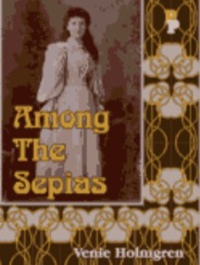
Venie Holmgren’s book of poetry about her mother Pearl Myslis
After early morning photos of the river and breakfast, we left the camper to dry after the chilly night dews and headed off around the town exploring the incredible heritage buildings that dominate more than anywhere else we have travelled. From beautifully restored hotels and houses, flourmills turned into art spaces and even the supermarket and the petrol station where we later filled up, were heritage places. The similarities to Daylesford and Hepburn were striking, similar size communities about the same distance from the metropolitan centre with a strong arts, heritage, tree change culture and tourist economy. And both have lots of places for sale but the downturn in real estate in the west makes property look cheap by comparison. We saw the school where Venie went until she was taken out aged 14 to help around the house, and the cemetery. At the Residency Museum where we discovered lots more about York including the Chinese and Albanian migrants, that local aboriginal people lived on the river bank reserve where we had camped as recently as the 1960s, and that the Residency had been the maternity wing of the nearby hospital from 1920 to 1961 so Lavinia Stella Rich was most likely born there.
We both enjoyed York in different ways, reconnection to roots for David, and a place that felt like home for Su but without so much of the indulgence and glitz tourism that has taken over our hometown.
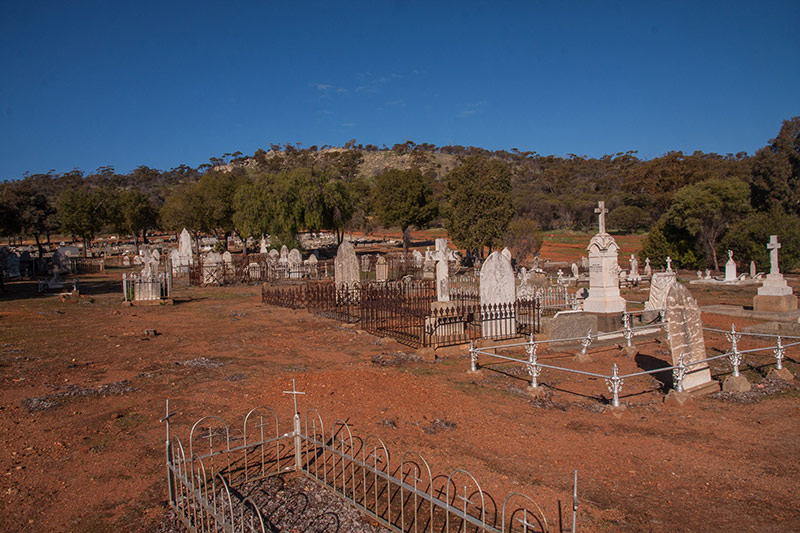
View over the town cemetery on the footslope of Mt Brown (Wongboral) where Venie Holmgren played as a child and where Dreamtime rebels such as her were punished
The final journey west took us up out of the cropping and grazing lands of the Avon and into the Wandoo and eventually the Jarrah/Mari forests of the Darling Range on the duel carriageway Great Eastern Highway still recognisable to David despite the development. Once down the escarpment of Greenmount, we followed a route David has followed on his last air journey to the west in 2015, so for him the freeways, industrial estates and suburbs in what was bushland and farming in his childhood was not so much of a shock. Su seemed remarkably relaxed driving through peak hour metropolitan traffic for the first time since leaving Sydney near six weeks ago. Our journey west ended at Ecoburbia in Beaconsfield on the edge of Fremantle where we were greeted by our hosts Shani Graham and Tim Darby as the sun sank into the Indian Ocean. A reconnection and a home coming for David, who was born in the Freo hospital down the hill in a room without air conditioning in a February heat wave (as Venie used to describe it).

The book exchange cabinet built by Tim on the public verge in front of Ecoburbia
<< Previous Chapter — — — Next Chapter >>— — —

























































































